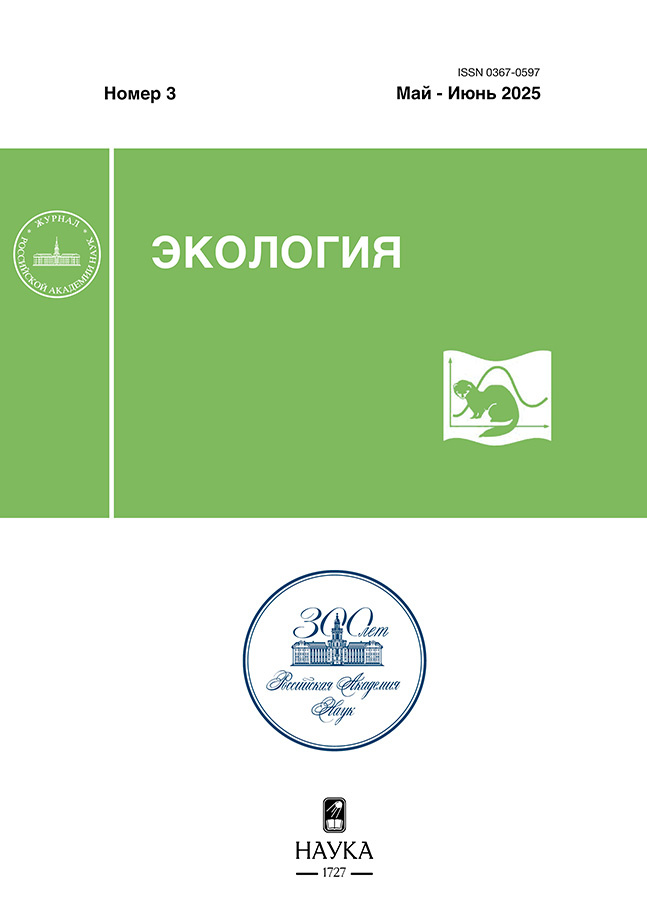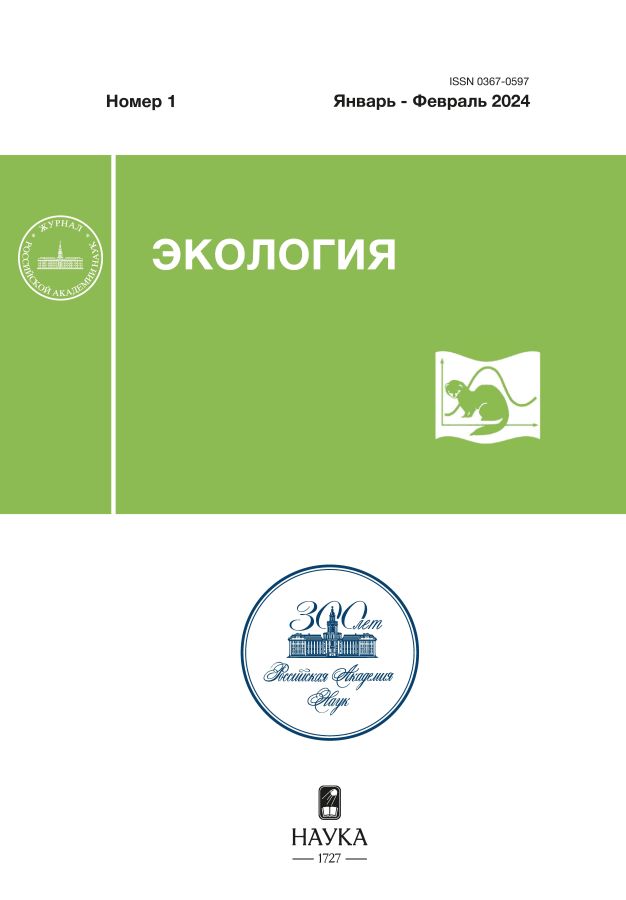Особенности горизонтальной структуры древесного яруса ценопопуляции Larix gmelinii (Rupr.) Rupr. в лесотундровом экотоне на полуострове Таймыр
- Авторы: Бондарев А.И.1, Секретенко О.П.1
-
Учреждения:
- Институт леса им. В. Н. Сукачева ФИЦ КНЦ СО РАН
- Выпуск: № 1 (2024)
- Страницы: 22-33
- Раздел: Статьи
- URL: https://kazanmedjournal.ru/0367-0597/article/view/673013
- DOI: https://doi.org/10.31857/S0367059724010035
- EDN: https://elibrary.ru/XCJDLF
- ID: 673013
Цитировать
Полный текст
Аннотация
Рассмотрены особенности горизонтальной пространственной структуры разновозрастных редколесий лиственницы Гмелина (Larix gmelinii (Rupr.) Rupr.), формирующих северную границу древесной растительности в лесотундровом экотоне в восточной части полуострова Таймыр. Установлено, что для всех исследованных древостоев характерна мозаичная структура, при которой участки, занятые древесной растительностью, чередуются с открытыми пространствами, площадь которых колеблется от 37 до 50%. В сложении древесного яруса во всех случаях участвуют как одиночные деревья, так и их агрегации (биогруппы), удельный вес которых варьирует от 17 до 32%. В биогруппах преобладает парная агрегация деревьев – 83%. Установлено преобладание случайного характера расположения деревьев в сложении горизонтальной структуры, однако конкретный тип пространственного распределения определяется также стадией онтогенеза, в которой находится ценопопуляция.
Полный текст
Об авторах
А. И. Бондарев
Институт леса им. В. Н. Сукачева ФИЦ КНЦ СО РАН
Автор, ответственный за переписку.
Email: abondarev@ksc.krasn.ru
Россия, 660036, Красноярск
О. П. Секретенко
Институт леса им. В. Н. Сукачева ФИЦ КНЦ СО РАН
Email: abondarev@ksc.krasn.ru
Россия, 660036, Красноярск
Список литературы
- Крючков В.В. Самые северные на земном шаре лесные массивы на р. Лукунской в бассейне р. Хатанги // Ботан. журн. 1972. Т. 57. № 10. С. 1213–1220.
- Payette S., Fortin M.J., Gamache I. The subarctic forest-tundra: the structure of a biome in a changing climate // Bioscience. 2001. V. 51. P. 709–718. https://doi.org/10.1641/0006–3568(2001)051[0709: TSFTTS]2.0.CO;2
- Clements F.E. Nature and structure of the climax // Journal of Ecology. 1936. V. 24. P. 253–284.
- Ranson K.J., Montesano P.M., Nelson R. Object based mapping of the circumpolar taiga–tundra ecotone with MODIS tree cover // Remote Sens. Environ. 2011. V. 115. P. 3670–3680. 10.1016/j.rse.2011.09.006' target='_blank'>https://doi: 10.1016/j.rse.2011.09.006
- Montesano P.M., Sun G., Dubayah R.O., Ranson K.J. Spaceborne potential for examining taiga–tundra ecotone form and vulnerability // Biogeosciences. 2016. V.13. P. 3847–3861. https://doi: 10.5194/bg-13–3847–2016
- Callaghan T.V., Crawford R.M., Eronen M. et al. The dynamics of the tundra-taiga boundary: An overview and suggested coordinated and integrated approach to research // Ambio. 2002. Special report № 12. Dynamics of the Tundra-Taiga Interface. P. 3–5.
- Stocker T.F., Qin G.-K., Plattner L.V. et al. Technical Summary // Climate Change 2013: The Physical Science Basis. Contribution of Working Group I to the Fifth Assessment Report of the Intergovernmental Panel on Climate Change. Eds. Stocker T. F., Qin D, Plattner G.-K. et al. Cambridge. Cambridge University Press, 2014. P. 33–115. https://doi: 10.1017/ CBO9781107415324.005
- Bader J. Climate science: The origin of regional Arctic warming // Nature. 2014. V. 509. P. 167–168. https://doi.org/10.1038/509167a
- Holtmeier F.-K., Broll G. Sensitivity and response of northern hemisphere altitudinal and polar treelines to environmental change at landscape and local scales // Global Ecol. Biogeogr. 2005. V.14. P. 395–410. https://doi.org/10.1111/j.1466–822X.2005.00168.x
- Грабарник П.Я. Анализ горизонтальной структуры древостоя: модельный подход // Лесоведение. 2010. № 2. C. 77–85.
- Dalen L., Hofgaard A. Differential regional treeline dynamics in the Scandes Mountains // Arct. Antarct. Alpine Res. 2005. V.37. P. 284–296. https://doi.org/10.1657/1523–0430(2005)037 [0284: DRTDIT]2.0.CO;2
- Danby R.K., Hik D.S. Variability, contingency and rapid change in recent subarctic alpine tree line dynamics // J. Ecol. 2007. V.95. P. 352–363. https://doi.org/10.1111/j.1365–2745.2006.01200.x
- Frost G.V., Epstein H.E., Walker D.A. Regional and landscape-scale variability of Landsat-observed vegetation dynamics in northwest Siberian tundra // Environ. Res. Lett. 2014. V.9. P. 1264–1277. https://doi.org/10.1088/1748–9326/9/2/025004
- Haugo R.D., Halpern C.B., Bakker J.D. Landscape context and long-term tree influences shape the dynamics of forest-meadow ecotones in mountain ecosystems // Ecosphere. 2011. V. 2(8). Article 91. P. 1–24. https://doi.org/10.1890/ES11–00110.1
- Lloyd A.H., Yoshikawa K., Fastie C.L. et al. Effects of permafrost degradation on woody vegetation at arctic treeline on the Seward Peninsula, Alaska, Permafrost Periglac // Permafrost and Periglacial Processes. 2003. V. 14(2). P. 93–101. 10.1002/ppp.446' target='_blank'>https://doi: 10.1002/ppp.446
- Харук В.И., Буренина Т.А., Федотова Е.Ф. Анализ экотона «лес-тундра» по данным космосъемки // Лесоведение. 1999. № 3. С. 59–67.
- Абаимов А.П., Бондарев А.И., Зырянова О.А., Шитова С.А. Леса Красноярского Заполярья. Новосибирск: Наука, 1997. 208 с.
- Тюлина Л.Н. Лесная растительность Хатангского района у ее северного предела // Тр. Арктического института. 1937. Т. 63. Геоботаника. С. 83–180.
- Кнорре А.В. Редколесья и редины Ары-Маса // Ары-Мас. Природные условия, флора и растительность самого северного в мире лесного массива. Л.: Наука, 1978. С. 162–183.
- Поспелов И.Н., Поспелова Е.Б., Чиненко С.В. Притундровые редколесья и редины бассейна р. Лукунской (восточный Таймыр) // Современные проблемы притундровых лесов: Мат-лы. Всерос. конф. с междунар. участием. Архангельск, 2012. С. 174–180.
- Поспелов И.Н., Поспелова Е.Б. О северном пределе распространения лиственницы Гмелина (Larix gmelinii (Rupr.) Rupr.) на Восточном Таймыре // Ботан. журн. 2013. Т. 98. № 5. С. 621–629.
- Абаимов А.П., Бондарев А. И. Критерии выделения категорий лесных земель в редкостойных лесах Севера // Лесоведение. 1997. № 1. С. 45–49
- Бондарев А.И. Таксационный очерк самых северных в мире лесов // Лесная таксация и лесоустройство / Межвуз. сб. науч. тр. Красноярск: КПИ, 1989. С. 35–39.
- Bondarev Alexander. Age distribution patterns in open boreal Dahurican larch forests of Central Siberia // Forest Ecology and Management. 1997. V. 93. № 3. P. 205–214. https://doi.org/10.1016/S0378–1127(96)03952–7
- Сукачев В.Н., Зонн С.В. Методологические указания к изучению типов леса. М.: Наука, 1961. 144 с.
- ОСТ 56–69–83. Площади пробные лесоустроительные. Метод закладки. М.: Госкомлес СССР, 1983. 60 с.
- Greig-Smith P. The use of random and contiguous quadrats in the study of the structure of plant communities // Ann. Bot. London, N.S. 1952. V. 16. P. 293–316.
- Плотников В.В. О путях развития древесных растений в связи с динамикой их численности в сообществе // Экология. 1973. № 3. С. 44–51.
- Кузьмичев В.В. Закономерности динамики древостоев: принципы и модели. Новосибирск: Наука, 2013. 208 с.
- Бузыкин А.И., Гавриков В.Л., Секретенко О.П., Хлебопрос Р.Г. Анализ структуры разновозрастных древесных ценозов // Анализ структуры древесных ценозов. Новосибирск: Наука, 1985. С. 50–80.
- Грейг-Смит П. Количественная экология растений. М.: Мир, 1967. 359 с.
- Morisita M. Measuring of the dispersion of individuals and analysis of the distributional patterns // Memoir of the Faculty of Science, Kyushu University. 1959. Series E: Biology. V. 2. № 4. P. 215–235.
- Ripley B.D. Spatial Statistics. John Wiley & Sons, 1981. 252 p.
- R Core Team R: a language and environment for statistical computing. Vienna: R foundation for statistical computing. 2019. http://www.r-project.org.
- Wieczorek M., Kruse S., Epp L.S. et al. Dissimilar responses of larch stands in northern Siberia to increasing temperatures – a field and simulation based study // Ecology. 2017. V. 98(9). P. 2343–2355. https://doi.org/10.1002/ecy.1887
- Василевич В. И. Статистические методы в геоботанике. Л.: Наука, 1969. 232 с.
- Поздняков Л.К. Мерзлотное лесоведение. Новосибирск: Наука, 1986. 192 c.
- Каволюнене Д.К. Типы размещения деревьев в свете закономерностей роста древостоев // Тезисы докл. научн. конф. Каунас, 1981. С. 40–42.
- Тябера А.П. Вопросы территориального размещения деревьев в сосновых древостоях // Лесной журнал. 1980. № 5. С. 5–7.
- Вайс А.А. Горизонтальная структура пихтовых насаждений // Вестник СибГТУ. 2005. № 1. С. 24–27.
- Вайс А.А. Горизонтальная структура древостоев Средней Сибири // Научный журнал КубГАУ. 2009. № 45 (1). С. 1–15.
- Москвина И.В., Гетманец И.А. Популяционная организация растительного покрова в подзоне южно-таежных лесов Челябинской области // Фундаментальные исследования. 2014. № 12-2. С. 322–326.
- Данилина Д.М., Назимова Д.И., Коновалова М.Е. Пространственно-временная структура и динамика позднесукцессионного черневого кедровника Западного Саяна // Лесоведение. 2020. № 5. С. 387–398. https://doi.org/10.31857/S0024114820050034
- Коновалова М.Е., Данилина Д.М. Структура ценопопуляций ключевых видов черневых кедровых лесов Западного Саяна на климаксовой стадии развития // Экология. 2019. № 3. С. 189–195. https://doi.org/10.1134/S0367059719030089
- Колтунова А.И. О формировании горизонтальной структуры и срастании корневых систем в древостоях сосны // Эко-потенциал. 2013. № 3–4. С. 136–142.
- Манов А.В., Кутявин И.Н. Горизонтальная структура древостоев и подроста северотаежных коренных ельников чернично-сфагновых в Приуралье // Лесн. журнал. Изв. высш. учеб. заведений. 2018. № 6. С. 78–88. https://doi.org/10.17238/issn0536-1036.2018.6.78
- Манов А.В. Горизонтальная структура древостоя и подроста ельника разнотравно-черничного средней тайги Республики Коми // Лесоведение. 2019. № 4. C. 286–293. https://doi.org/ 10.1134/S0024114819030069
- Манов А.В., Кутявин И.Н. Структура древостоя в старовозрастном постпирогенном сосняке бруснично-лишайниковом в бассейне реки Печоры // Лесоведение. 2018. № 6. С. 434–443. https://doi.org/ 10.1134/S0024114818050054
Дополнительные файлы















